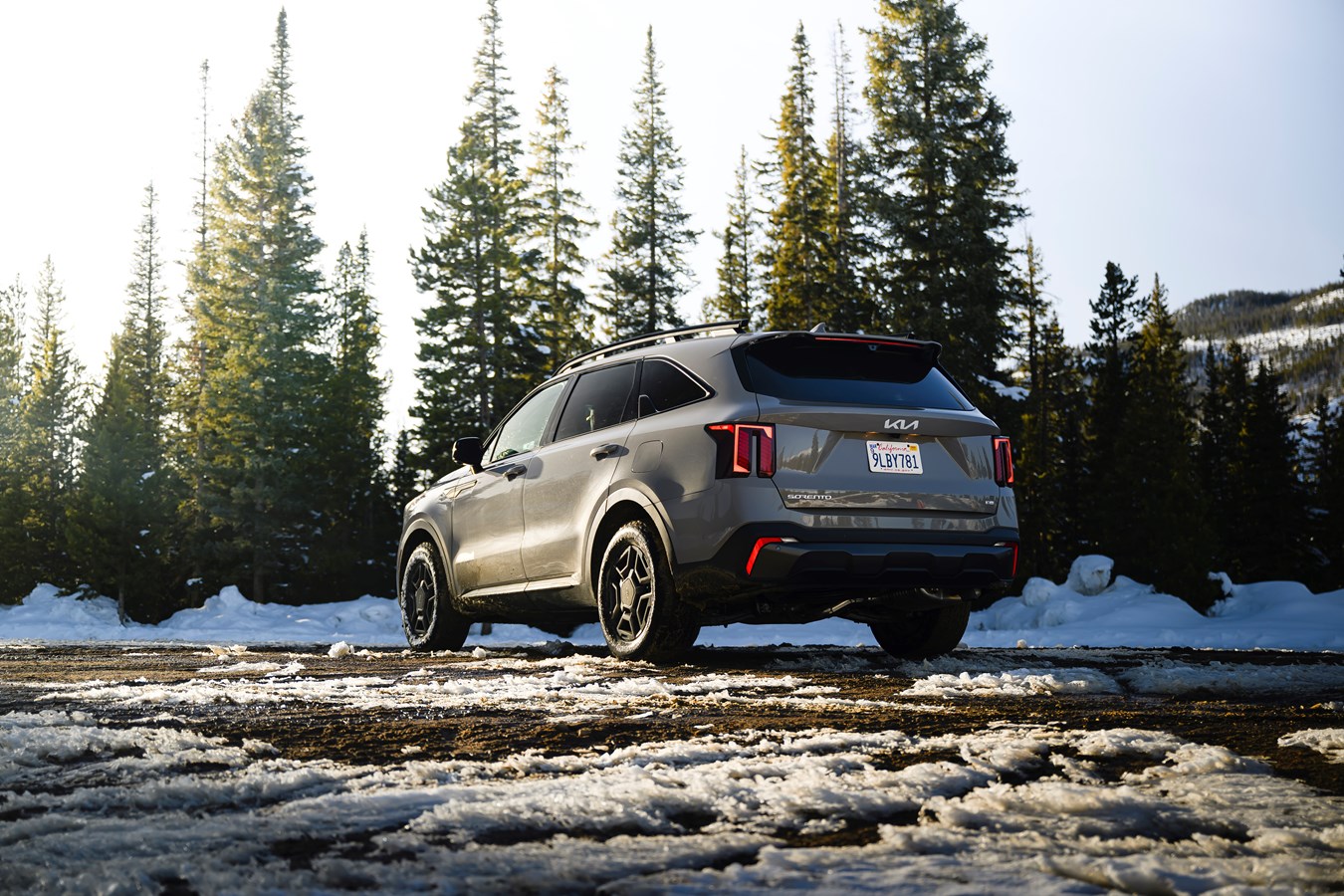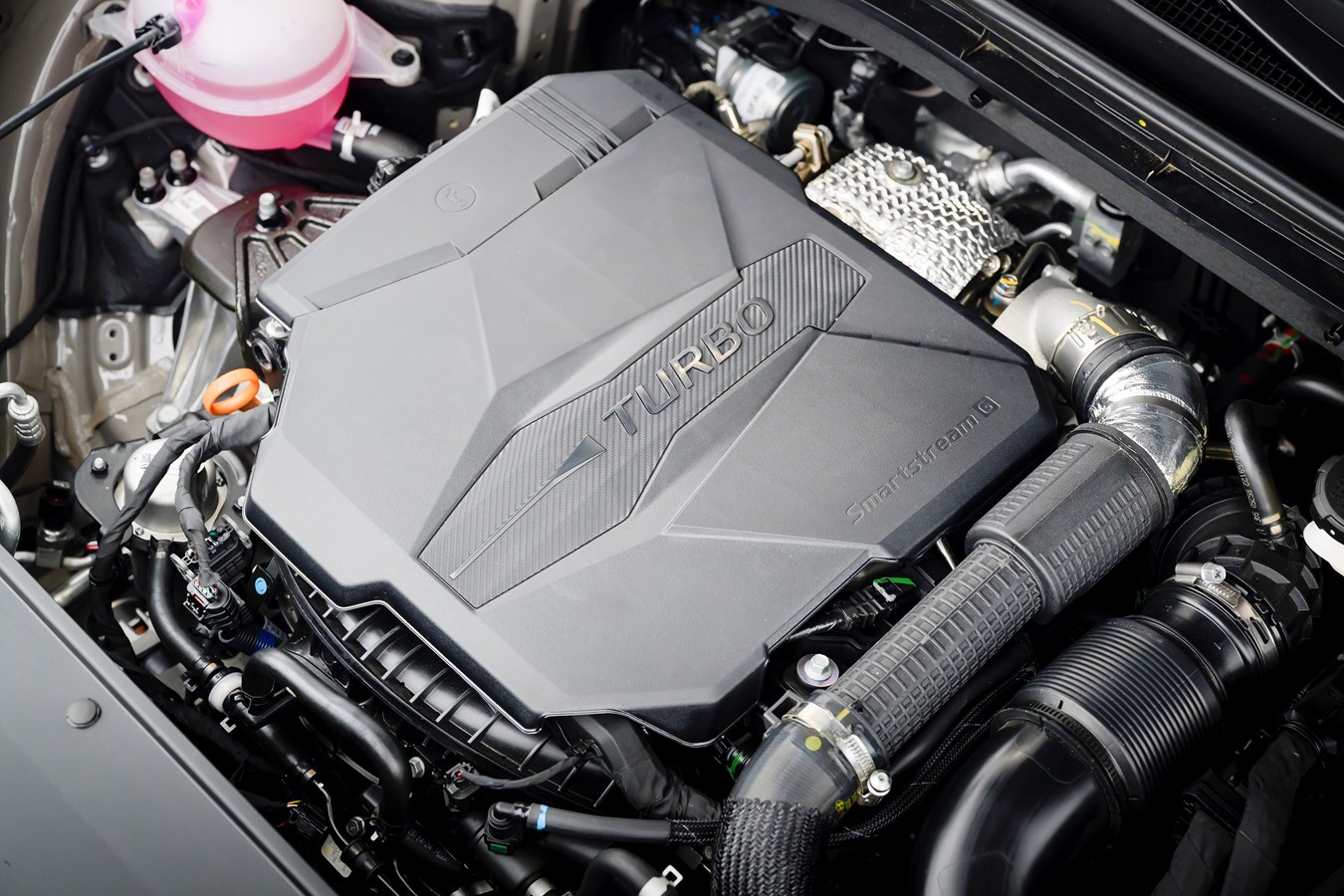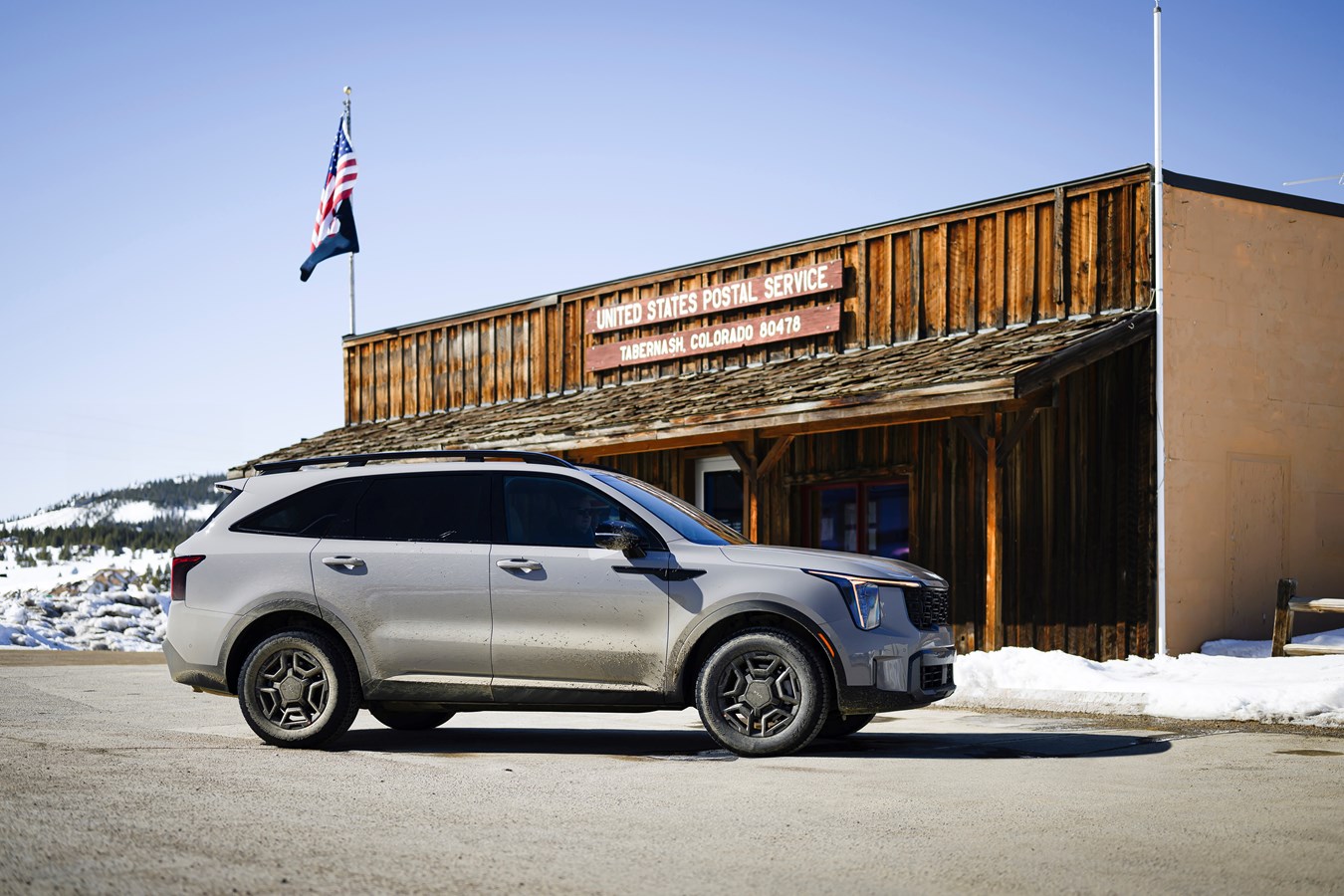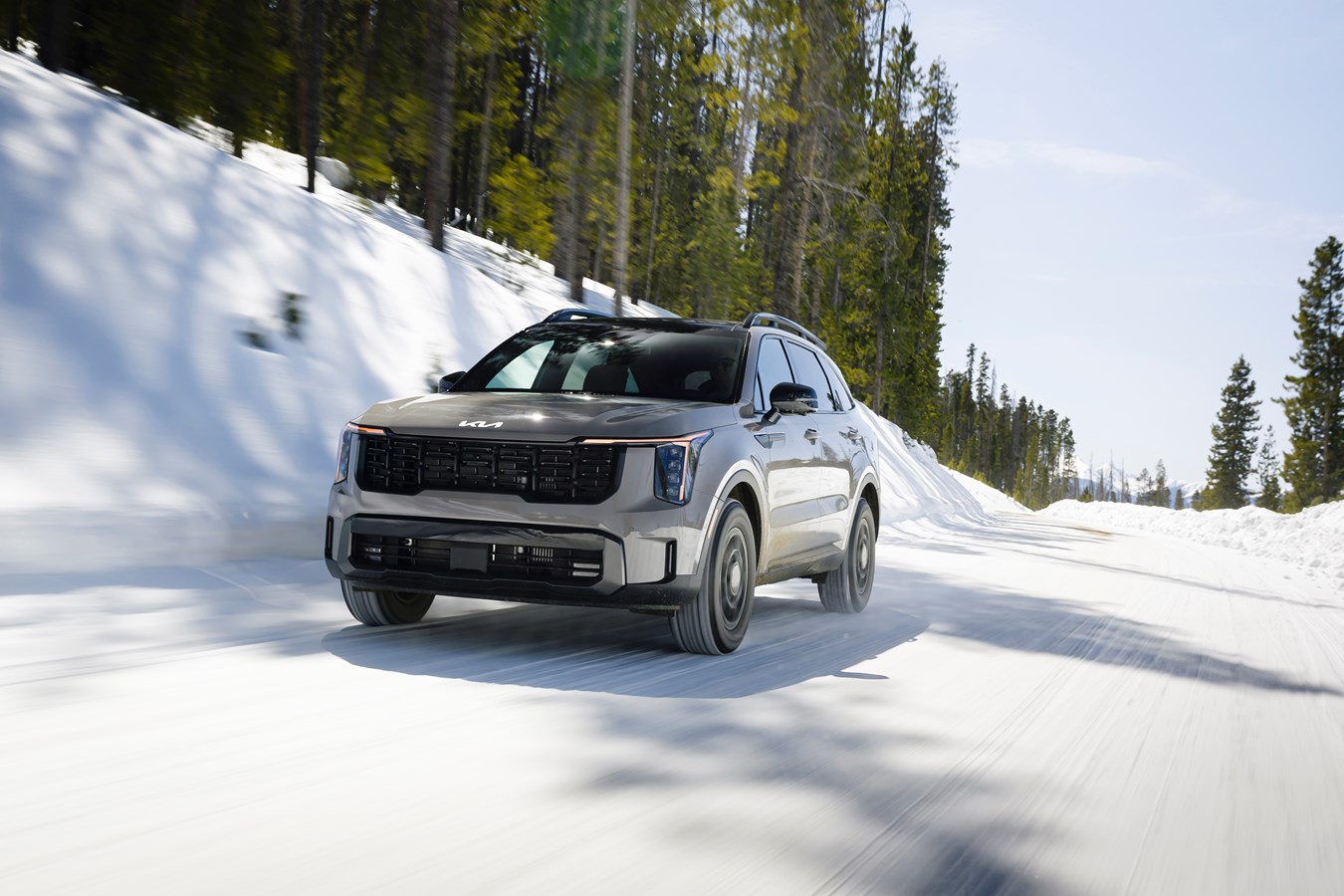We have not covered Kia with any regularity on Expedition Portal or in Overland Journal. It’s not a manufacturer that has much of a legacy in the 4WD world, but if you cast your mind back to the turn of the century, you may remember the tiny first-generation Kia Sportage (1993-2002) and its successor, the first-gen Sorento (2002-2009). Both of these SUVs had body-on-frame construction and true 4WD with low range and optional manual transmissions. Two decades later, the landscape of adventure vehicles looks very different. With the keys to the 2024 Kia Sorento X-Pro in my hand at 8,700 feet in the snowy, late-winter mountains of Colorado, it was time to see what the Korean automaker could do with a contemporary unibody crossover with off-road ambitions.

Kia Sorento Basics
The Sorento is Kia’s mid-size, 6-passenger, 3-row SUV, and it comes in a wide variety of trims, many of which are meant for the elementary school run or rental car fleets. We’ll set aside those lower-spec models to focus on the top-of-the-line SX-Prestige trim, the only Sorento that is available with the adventure-angled X-Pro package. The SX-Prestige comes standard with a turbocharged 2.5-liter four-cylinder GDI engine rated at 281 horsepower and 311 pound-feet of torque. An 8-speed wet dual-clutch transmission with manual mode sends power to all four wheels via an on-demand all-wheel-drive system.
- The Sorento’s interior is thoughtfully laid out.
- Even on trail terrain tires, the X-Pro has excellent road manners.
In a move upmarket, Kia lavishes the Sorento SX-Prestige with a full entourage of modern technology, including plenty of safety and convenience-oriented driver aids. The interior feels premium both in its materials as well as its design, with soft-touch plastics and surprisingly luxurious fabrics, such as the headliner material, and even the carpeting. The cowl is admirably low for a modern SUV, which enhances both visibility and the feeling of airiness in the cabin. The dash, dominated by two 12.3-inch horizontal TFT displays, is uncluttered but also features useful knobs and buttons for controlling the most common functions. Menus on the center touchscreen are intuitive and simple to navigate—Kia put a lot of effort into the UX/UI in the Sorento. It’s easy to jump into this crossover for the first time and feel at home right away.

- The center touchscreen is bright and responsive, with no latency.
- Second-row captain’s chairs.
If you hop in the back seat, you’ll find two captain’s chairs (rather than the usual bench seat) that tip forward to aid access to the third row. The third row—a feature that many buyers in this segment seem to demand—is not the domain of adults and, when deployed, eliminates most of the storage room in the cargo area. If your family needs the extra seats and you are planning on long road trips or extended adventures, I recommend looking a few pages further in the Kia catalog to find the larger Telluride.
The Sorento’s major change for 2024 is the exterior styling. The design language updates the look to bring it into aesthetic step with the rest of Kia’s lineup. The upright grille and vertical headlights give the Sorento a purposeful, square-jawed presence framed by the manufacturer’s signature amber LED running lights. The X-Pro models we drove featured the hue-shifting Road Rider Brown paintwork that complemented the matte-black 17-inch wheels that are exclusive to the X-Pro trim.
- New styling for the Sorento’s front fascia.
- The third row of seats hampers storage capacity.
The X-Pro Philosophy
The X-Pro package does for the Sorento what TrailSport, Wilderness, and TRD-Pro trims do for the Honda Passport, the Subaru Outback, and the Toyota RAV-4. The formula is straightforward—take a modest AWD SUV and add a handful of options that ostensibly improve its off-highway capabilities. This can include smaller wheels but larger knobbier tires, enhancements to the 4WD and traction control systems, a roof rack for some extra utility, a small suspension lift, and perhaps some body armor for a little more peace of mind off-piste. (See Overland All the Things! for more on this phenomenon.) These are easy and profitable upgrades for the manufacturer, and they boost the model’s general perception as an adventure vehicle.

X-Pro wheels are 17 inches in diameter, and I found the design to be quite busy.
It is these option packages that might make a run-of-the-mill crossover a little more appealing to the overland travel crowd, but it’s important to reflect on their limitations. Here’s what a Sorento X-Pro nets the buyer on top of the standard SX-Prestige trim:
- Unique 17-inch wheels
- BFGoodrich 235/65/17 Trail Terrain tires (Kia calls them “all-terrain”)
- Locking center differential for the active on-demand torque-vectoring AWD system
- Hill descent control
- A bridge-type roof rack that supports 176 pounds
- A standard towing package with 4,500 pounds of towing capacity
- Unique bumpers with molded-in cosmetic skid plates
- X-Pro badging inside and out
The Sorento X-Pro also has 1,563 pounds of payload capacity, and the impressive tow rating for this segment is thanks to an improved engine cooling system. The center-locking differential splits the power distribution 50/50 front to back, while the brake-based torque vectoring system handles traction side to side. Similar X-Pro trims are also available on the smaller Sportage, as well as the Telluride.
Without a doubt, these are all useful upgrades for drivers with trail-tackling aspirations, but there are some constraints to consider. Despite Kia’s claims about the X-Pro’s “all-terrain” rubber, those BFGs are the Trail Terrain model, a lighter-duty tire with two-ply sidewalls. While they showcased excellent traction in mixed driving conditions, KO2s, they are not. All AWD Sorentos have 8.2 inches of ground clearance (with no extra lift for the X-Pro), and the approach, departure, and breakover angles are a decidedly humble 16, 22, and 17 degrees, respectively. There is no underbody protection to speak of, save for some composite splash shields, and the AWD system does not have any trail-specific driving modes.

At the first drive event in Winter Park, Colorado, Kia executives and engineers were sanguine about the X-Pro’s purpose. It’s not a Wrangler Rubicon by any stretch of the imagination (though it has more payload capacity than the Jeep), and it wasn’t billed that way. Kia aims the X-Pro at families with an active lifestyle who may want to stretch their adventures a little further down the track than a more basically equipped Sorento might.
The Sorento X-Pro On Road and Off (Sort of)
With the Centennial State’s cloud-hugging 14ers looming in the distance through the Sorento’s panoramic sunroof, we took off for a 230-mile driving loop with a promised “off-road” section in the mountains where we could put some of the X-Pro’s upgrades to the test. Power delivery is excellent through the 8-speed dual-clutch transmission (with luck, Kia has nipped this gearbox’s reliability problems in the bud), and with a 0-60 mph time of just 7 seconds, it has plenty of power to handle the Sorento’s 4,000-pound curb weight. On Grand County’s curvy mountain passes and cantilevered two-lane highways, the Sorento handled with confidence (even on the softer, taller sidewall tires), with the Sport driving mode and the paddle shifters adding some engagement to the driving experience.

The other drive modes, selected from a knurled knob on the center console, include Normal, Eco, Snow, and Smart. The Smart mode adapts to your driving style as it learns your habits behind the wheel and works in concert with the Sorento’s array of automated safety technologies, including lane-departure assist, forward collision avoidance, and adaptive cruise control. The digital rearview mirror and 360-degree camera system are useful both in the parking lot and potentially on the trail. Driver ergonomics were excellent, and the heated and cooled front seats proved to be all-day comfortable.
I expected good dynamics on the pavement from a unibody crossover platform that’s been in development for nearly five years, but I was most curious to see how the X-Pro would handle some gnarlier roads and more variable traction situations. Unfortunately, we had hit a weather window that was particularly sunny and dry for early March in Colorado’s high country, and the “off-road” section of the drive didn’t offer much insight into the car’s capabilities. A gravel county road pockmarked here and there with some puddles and potholes took us past a gigantic mining operation (fun fact: the world’s largest molybdenum mine is located in Colorado) and over 9,000-foot Ute Pass before descending to the Interstate 70 corridor.

The Sorento X-Pro features multiple drive modes and a center-locking differential.
The X-Pro was sure-footed in the muddier and snowier sections of the drive, and the center-locking differential operated seamlessly as far as I could discern, but the route wouldn’t have been much of a challenge even for a Kia Forte sedan. We didn’t encounter any particularly steep terrain or cross-axle obstacles to tax the AWD, traction control, or braking systems, never mind hill descent control, so I’ll refrain from a final judgment of the X-Pro’s trail chops. Modified versions of the Sorento have fared well in their class at the Rebelle Rally, so some potential is clearly there. In all, the Sorento X-Pro is a well-engineered and very competent 3-row crossover that is sure to have wide appeal for Kia, especially with its sharply redesigned interior and exterior.
Is the Sorento X-Pro Overland Ready?
At the bottom of Ute Pass, I had a moment to make a handful of notes about my time with the Sorento X-Pro. Like the molybdenum that makes bearing grease slippery, it was a little difficult to get a handle on where Kia’s midsize crossover might land for potential buyers with overland travel goals. The factory roof rack will easily accommodate a smaller roof tent, and the generous cargo area (65 cubic feet) should swallow a fair amount of gear right up to the payload max (with the third-row seats stowed, of course). The 4,500-pound town rating means plenty of adventure trailers will be in play for travelers who like to set up a base camp.

The rear seats fold flat for easy storage access.
But once you leave camp, the modesty of the X-Pro’s “off-road” upgrades will limit where you might try to explore. Aftermarket support for this platform is essentially nonexistent, so finding functional add-ons like steel skid plates or improved suspension components, for example, will be close to impossible. And, as a colleague at the Colorado event emphasized, the X-Pro package is only available on the full-board SX-Prestige model. With high-end materials and a lack of rubber floor linings, the interior appointments found at this trim level might almost be too nice for a rough-and-tumble overland adventure.

Our “off-road” loop wasn’t terribly challenging, but the Sorento can still get dirty.
Finally, there’s the Sorento X-Pro’s MSRP. My test vehicle was fully loaded and came in at $49,400. Kia historically has had a solid reputation as a good value proposition, but that is going to be a hefty monthly payment at this price point. If you need three rows, the Kia Telluride X-Pro should be on your radar for not much more money (starting around $51,000). If you don’t, the Subaru Outback Wilderness may be an interesting alternative. Kia doesn’t see the Outback as a direct competitor to the Sorento, but the Wilderness’ better ground clearance, functional body armor, and a price tag that’s $10,000 less might tip the balance.
$49,400 | kia.com
Read more: Subaru Crosstrek Wilderness :: First Drive
Images: Stephan Edwards, Kia
Our No Compromise Clause: We do not accept advertorial content or allow advertising to influence our coverage, and our contributors are guaranteed editorial independence. Overland International may earn a small commission from affiliate links included in this article. We appreciate your support.








